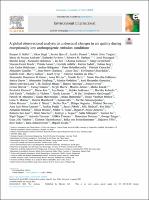A global observational analysis to understand changes in air quality during exceptionally low anthropogenic emission conditions
Metadata
Show full item recordAuthor(s)
Date
2021-08Collections
- Artículo científico [171]
Related Resource(s)
https://www.sciencedirect.com/science/article/pii/S0160412021004438?via%3Dihub#!Abstract
This global study, which has been coordinated by the World Meteorological Organization Global Atmospheric Watch (WMO/GAW) programme, aims to understand the behaviour of key air pollutant species during the COVID-19 pandemic period of exceptionally low emissions across the globe. We investigated the effects of the differences in both emissions and regional and local meteorology in 2020 compared with the period 2015–2019. By adopting a globally consistent approach, this comprehensive observational analysis focuses on changes in air quality in and around cities across the globe for the following air pollutants PM2.5, PM10, PMC (coarse fraction of PM), NO2, SO2, NOx, CO, O3 and the total gaseous oxidant (OX = NO2 + O3) during the pre-lockdown, partial lockdown, full lockdown and two relaxation periods spanning from January to September 2020. The analysis is based on in situ ground-based air quality observations at over 540 traffic, background and rural stations, from 63 cities and covering 25 countries over seven geographical regions of the world. Anomalies in the air pollutant concentrations (increases or decreases during 2020 periods compared to equivalent 2015–2019 periods) were calculated and the possible effects of meteorological conditions were analysed by computing anomalies from ERA5 reanalyses and local observations for these periods. We observed a positive correlation between the reductions in NO2 and NOx concentrations and peoples’ mobility for most cities. A correlation between PMC and mobility changes was also seen for some Asian and South American cities. A clear signal was not observed for other pollutants, suggesting that sources besides vehicular emissions also substantially contributed to the change in air quality.
As a global and regional overview of the changes in ambient concentrations of key air quality species, we observed decreases of up to about 70% in mean NO2 and between 30% and 40% in mean PM2.5 concentrations over 2020 full lockdown compared to the same period in 2015–2019. However, PM2.5 exhibited complex signals, even within the same region, with increases in some Spanish cities, attributed mainly to the long-range transport of African dust and/or biomass burning (corroborated with the analysis of NO2/CO ratio). Some Chinese cities showed similar increases in PM2.5 during the lockdown periods, but in this case, it was likely due to secondary PM formation. Changes in O3 concentrations were highly heterogeneous, with no overall change or small increases (as in the case of Europe), and positive anomalies of 25% and 30% in East Asia and South America, respectively, with Colombia showing the largest positive anomaly of ~70%. The SO2 anomalies were negative for 2020 compared to 2015–2019 (between ~25 to 60%) for all regions. For CO, negative anomalies were observed for all regions with the largest decrease for South America of up to ~40%. The NO2/CO ratio indicated that specific sites (such as those in Spanish cities) were affected by biomass burning plumes, which outweighed the NO2 decrease due to the general reduction in mobility (ratio of ~60%). Analysis of the total oxidant (OX = NO2 + O3) showed that primary NO2 emissions at urban locations were greater than the O3 production, whereas at background sites, OX was mostly driven by the regional contributions rather than local NO2 and O3 concentrations. The present study clearly highlights the importance of meteorology and episodic contributions (e.g., from dust, domestic, agricultural biomass burning and crop fertilizing) when analysing air quality in and around cities even during large emissions reductions. There is still the need to better understand how the chemical responses of secondary pollutants to emission change under complex meteorological conditions, along with climate change and socio-economic drivers may affect future air quality. The implications for regional and global policies are also significant, as our study clearly indicates that PM2.5 concentrations would not likely meet the World Health Organization guidelines in many parts of the world, despite the drastic reductions in mobility. Consequently, revisions of air quality regulation (e.g., the Gothenburg Protocol) with more ambitious targets that are specific to the different regions of the world may well be required.
The following license files are associated with this item:








